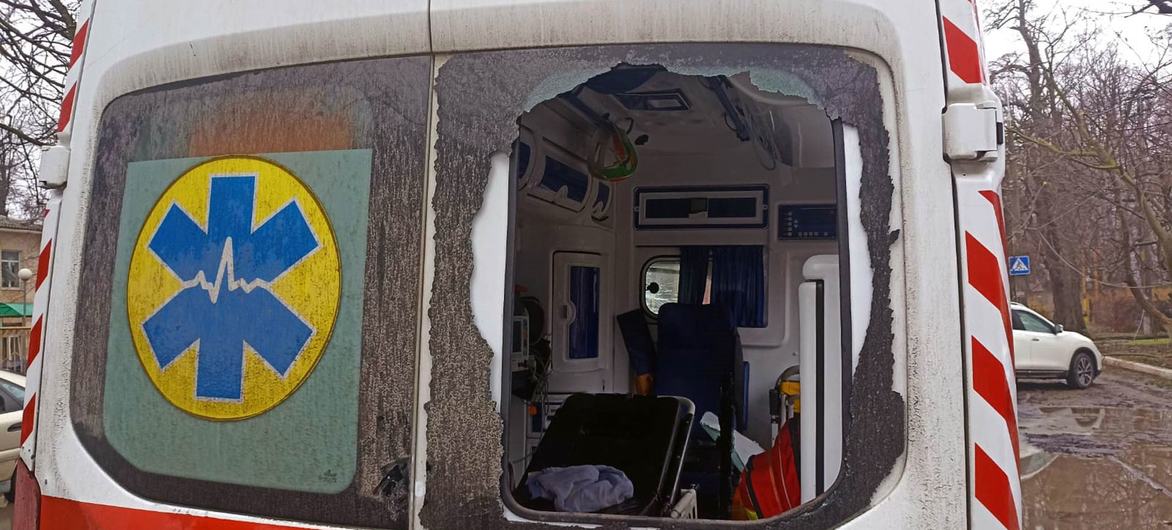“Relentless aerial attacks continue, prolonging and exacerbating an already dire situation,” said UN refugee agency (UNHCR), spokesperson Shabia Mantoo. “More than two years since Russia’s full-scale invasion, regular shelling and attacks continue to claim lives and destroy homes and critical infrastructure across the country.”
Ms. Mantoo noted that in the past week, more than 10,300 people have been evacuated from their villages in Kharkiv region’s border areas by Ukrainian authorities, with the help of volunteers and humanitarian organisations.
The majority of the evacuees are “highly vulnerable” people, including the elderly and people with low mobility or disabilities, who were not able to flee their homes previously.
Russian military advances
According to UN humanitarian affairs coordination office, OCHA, over 16,000 people are estimated to have fled the most affected localities in the Kharkiv region since 10 May amid reports of significant advances by Russian forces.
Inside Kharkiv – Ukraine’s second largest city which already hosts some 200,000 internally displaced people – conditions “could become even more difficult if the ground offensive and relentless aerial attacks continue”, Ms. Mantoo warned. “This could force many people to leave Kharkiv for safety and survival, seeking protection elsewhere.”
The UNHCR spokesperson highlighted the fact that attacks on energy infrastructure are “particularly critical” in Kharkiv, where the energy supply is already “well below standard capacity” and households suffer from power shortages.
Civilian toll
Meanwhile, OCHA reported that the past three days have seen daily attacks in Kharkiv City resulting in “scores of civilian casualties including children and a pregnant woman”, citing local authorities, “as well as an ambulance hit and a paramedic injured when two strikes reportedly impacted the same location in close succession”.
Speaking from Kyiv, UN World Health Organization (WHO) representative in Ukraine Dr. Jarno Habicht said that since the start of Russia’s full-scale invasion of Ukraine in February 2022, “on average, 200 ambulances per year are damaged or destroyed in shelling attacks.”
“That is a tremendous loss, depriving the Ukrainian people of urgent care,” he insisted.
20,000 amputations
Overall, WHO has recorded more than 1,700 attacks on health in the country since February 2022, Dr. Habicht said.
The UN health agency representative added that some 10 million people in the country are likely suffer from mental health conditions, while more than 20,000 amputations have been conducted since the start of Russia’s full-scale invasion – “two areas [which] need support from many humanitarian and development partners and in the long term”.
While the intensification in hostilities in the Kharkiv region has driven humanitarian needs up “exponentially”, Dr. Habicht also highlighted the need to “think medium term to get ready for the winter to come”.

Ukraine’s health system has been devastated by the war.
To ensure Ukraine’s healthcare system can “continue functioning amidst prolonged adversity”, WHO has begun installing “modular heating units” in hospitals, including in Chernihiv and Odesa in the coming days and weeks, Dr. Habicht said.
But, responding to both immediate and medium-term needs and preparing the winter response has been a challenge due to a drop in humanitarian funding for Ukraine compared to the past two years.
According to OCHA, the UN’s $3.1 billion Humanitarian Needs and Response Plan for the country in 2024 remains only 23 per cent funded. UNHCR’s response in Ukraine and in neighbouring refugee-hosting countries is only 16 per cent funded, which, at the approach of the mid-year mark, is “abysmal”, Ms. Mantoo said.



